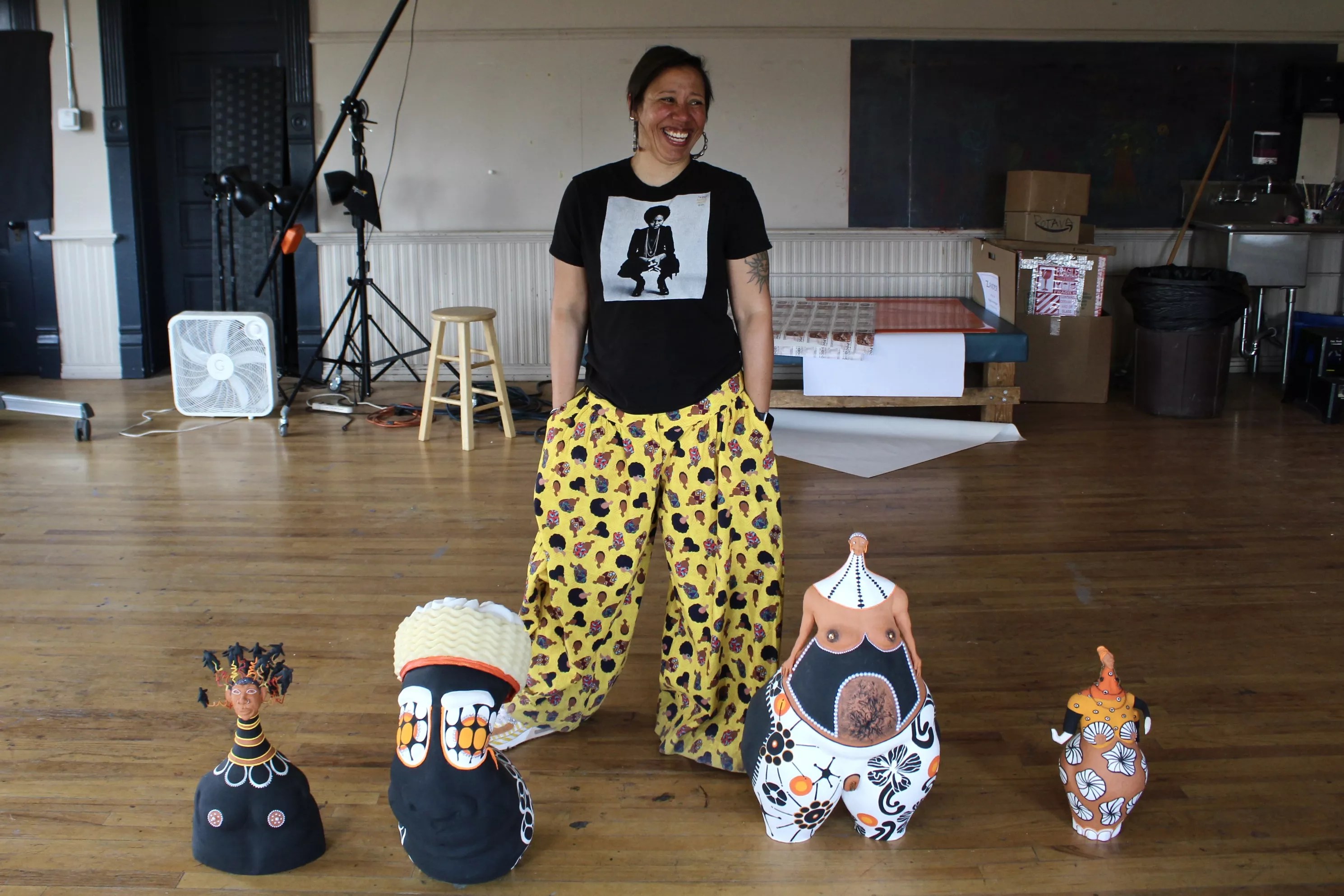
Kristen Fiore

Audio By Carbonatix
What do bed foam, pig intestines, clay, dominoes and velvet printed with a food-stamp pattern have in common? They’re all materials used in Desi Brown’s exhibit at the Art Students League of Denver, I Can Show You Better Than I Can Tell You.
“Artists explore,” Brown says matter-of-factly. “We’re always doing something, and we love material. I’m always exploring with new materials, especially materials that are cheap or lower value.” Walmart has been a good source, and so is salvaging trash.
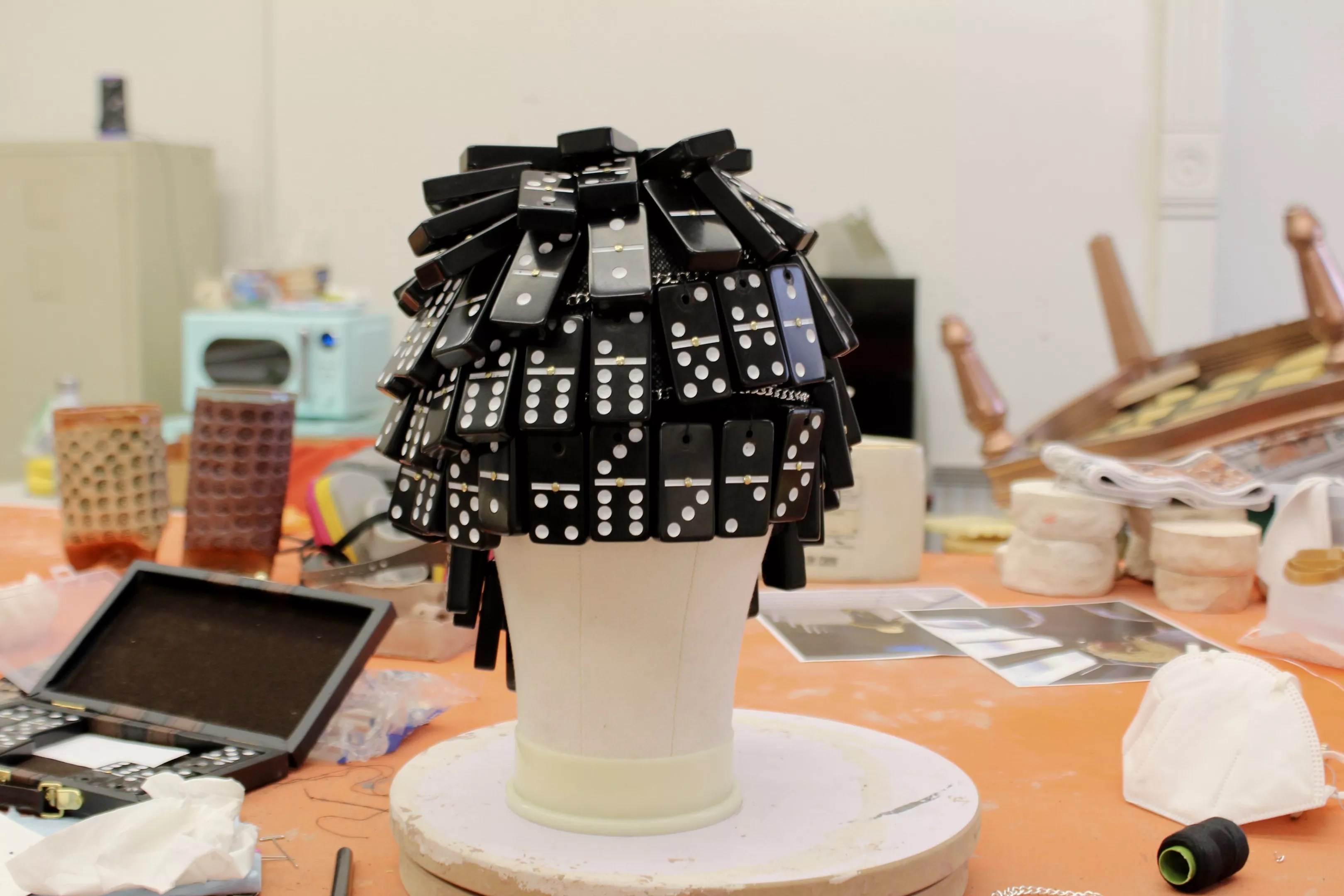
Brown’s son loves to play dominoes, so she made a wig out of them.
Kristen Fiore
Brown’s exhibit is the culmination of her Visiting Artist of Color Residency at ASLD, which is based in an 1893 building that was once a school and now holds classrooms and studios for Denver art students of all ages and levels.
Denver, make your New Year’s Resolution Count!
We’re $17,500 away from our End-of-Year campaign goal, with just a five days left! We’re ready to deliver — but we need the resources to do it right. If Westword matters to you, please contribute today to help us expand our current events coverage when it’s needed most.
I Can Show You Better Than I Can Tell You, currently displayed on both floors of the ASLD building, touches on the beauty of Brown’s experience as a single Black mother with four children. The theme has played a big role in most of her life. “I grew up with a single mother,” Brown recalls. “My mom is White. She had two Black kids, and growing up in Cheyenne, Wyoming…it was different.”
Brown got pregnant at the age of sixteen, got married, got a place with her husband and rode her bike to her two jobs – one selling vacuums and one at McDonald’s – all while working to finish high school. “I did finish high school,” she says. “I had to go to an alternative school, the actual main high school and to a college to finish school. It was a lot.”
She later moved to Georgia with her husband. They were young and the marriage didn’t work out, so she moved to Indiana, went to college and eventually had three more kids.
“I think of my mother saying, ‘Since you’re grown now and you want to do these things, you need to go figure this out’ – if she wouldn’t have said that, I don’t think I would have been able to do the things that I do now. You have to be able to rely on yourself,” Brown says.
And so she did. Brown ultimately got her MFA in fine arts from Purdue University and landed the residency at ASLD after a professor encouraged her to apply. Denver appealed to her, since her oldest child lives here. “It’s been so good,” she says. “I can’t believe it’s almost over. It’s an artist’s dream to be able to go somewhere and practice and fine-tune your language.” Brown moved to Denver with her two younger children and plans to stay in the Mile High city and continue growing her work after the residency ends.
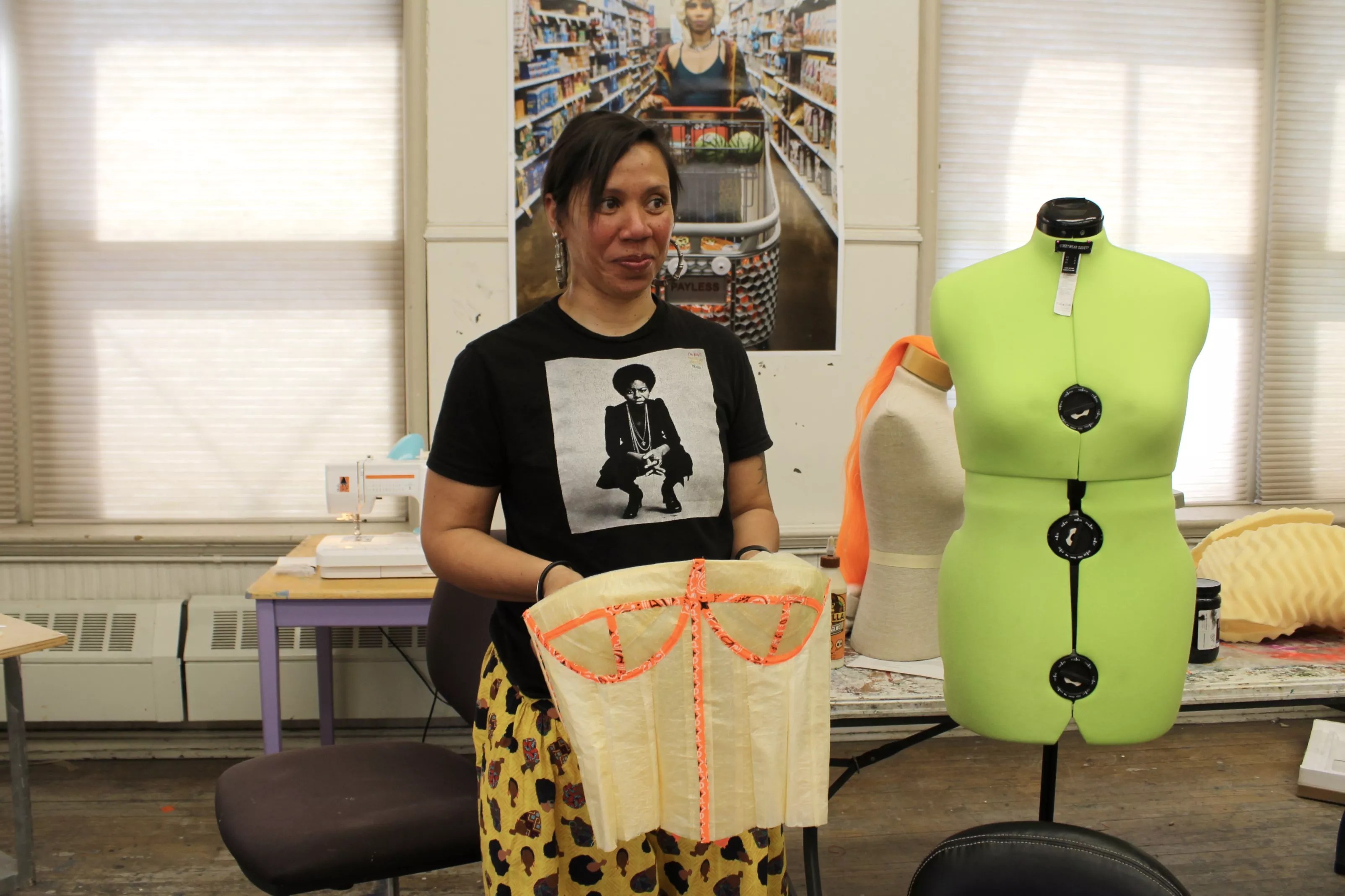
Brown holds a corset made out of pig intestines.
Kristen Fiore
Brown’s language in I Can Show You Better Than I Can Tell You is mainly 3D works of art – sculptures, fiber arts and ceramics. She uses unconventional materials with personal meaning like dominoes to make wigs, bed foam to make big skirts, and pig intestines to make corsets. “I’m obsessed with the Elizabethan era because it was glamorous – and the detail, the pearls,” Brown says. “You see them on White bodies, but you never see them on Black bodies. I can put them there.”
The food-stamp fabric lines some of the exhibit walls and was also used to reupholster Marie Antoinette-style chairs. “I’m a little obsessed with Marie Antoinette,” Brown admits. “She was young, they hated her because she did what she wanted to do, and she just happened to be a woman in that time. This is my interpretation of Desi Antoinette.”
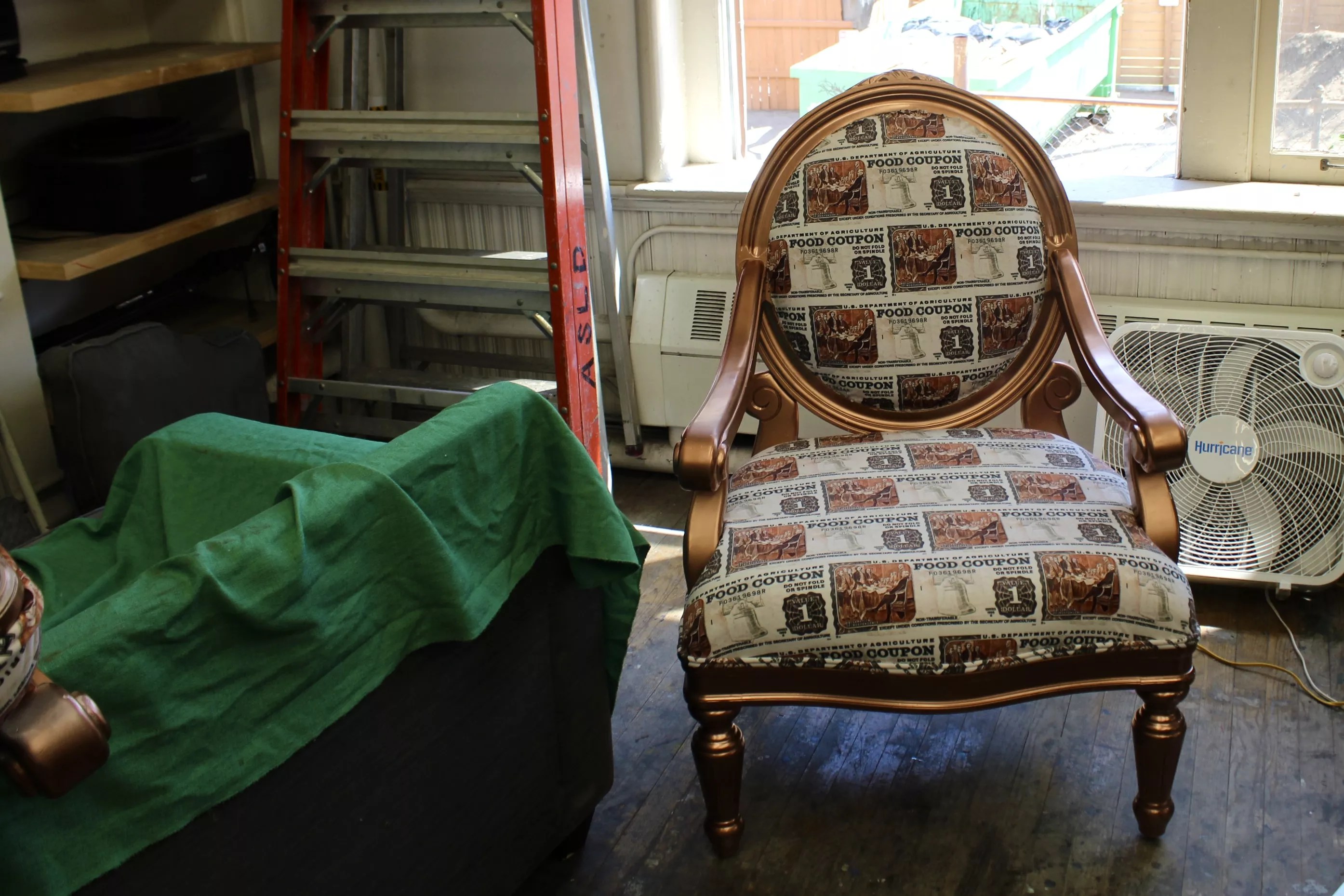
A chair reupholstered with velvet food stamp fabric.
Kristen Fiore
Brown doesn’t want the food-stamp imagery to be equated to Black people – to her, it represents being a poor single mother. “Even though I received assistance, I was going to school. I was riding my bike to work. I was pregnant. I had two jobs,” she says.
Brown also sculpted whimsical clay figures that represent herself and her children through toyish heads and stretch marks. Photos of Brown wearing some of her creations make up a 2D element of the show. The color orange appears frequently, and it has a special meaning for Brown.
“When I graduated undergrad, I got a job as a social worker. I got to buy a dresser for the first time with my own money,” Brown recalls. “I was super excited. I went to a garage sale and I bought an orange dresser and I still have it to this day. Orange to me means financial freedom.”
Brown hopes the exhibit will show people how creative Black women, especially Black mothers, can be. “I want Black people in Denver and Brown girls to be seen,” she says. “I can’t stress how important that is. When you live in a world where you’re not the forefront of any conversation, or most conversations, even in the media, anywhere…just to be seen when you come into a space this big.”
“I think what I take away from it is that she is speaking about humanity,” adds Tessa Crisman, ASLD director of communications and development. “People look at her artwork and sometimes pigeonhole it to be Black art, and that’s a really complicated thing, the way people deny Black artists in the wider art world, and I think what she’s doing is saying, ‘I’m speaking to humanity. This is who I am as a human, and I couldn’t speak it any other way.'”
Through her residence, Brown feels she’s gained more confidence and independence as an artist. “In school, you have these constant critiques from professional artists and professors. Of course, they have practice, they have an eye, they can see things,” she says. “So when you come out, you have to be more confident in your work. You don’t need that extra eye.”
Brown may no longer need that extra eye thanks to her residency, but the residency itself needs extra help. Previously, the seven-month residency came with a large studio space at ASLD and monthly stipends for housing, living expenses and art supplies. Starting with the next residency, the living and housing stipends will be lumped into one sum.
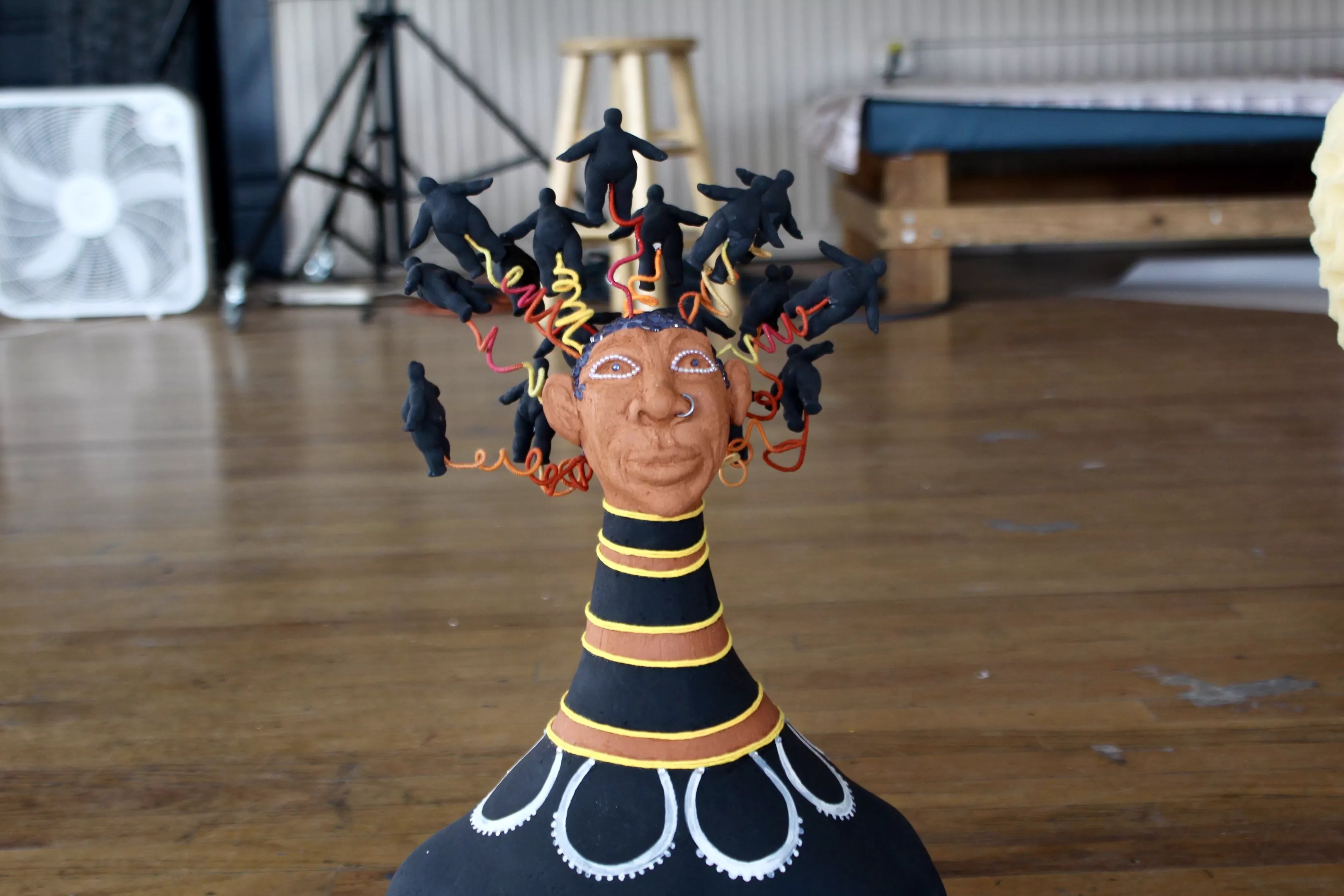
Brown sculpted whimsical clay figures that represent herself and her children.
Kristen Fiore
“Ever since its birth, it’s become more and more uncertain how we will be able to finance it,” Crisman says of the residency. “For a while, we got funding from the NEA. With the way things are going, that funding will likely not be available to us anymore. So we’re always looking for new champions of this work.”
Recognizing that the art world is often set up in a way that artists of color don’t have equal access, the ASLD established the Visiting Artist of Color Residency in 2021, choosing one artist a year from an international call. “It’s about giving people the tools they need to be artists, which this society does a really bad job of,” Crisman says. The artists get to start their residency without any expectations of what they’ll do or say with their art.
Even as the program faces funding challenges, “we’re all more dedicated to making it work, because we get to see how powerful it is,” Crisman notes.
I Can Show You Better Than I Can Tell You communicates the power of taking action over an issue, idea or feeling rather than just talking about it. “Now I’m just going to do it instead of talking,” Brown explains. “People always say what they’re going to do. Showing is so much better.”
Brown picks up one of her clay figures, a long-necked woman with pearl-crested eyes and pops of red, yellow and orange. “She has all these kids in her hair,” she says, “but it could be her crown.”
I Can Show You Better Than I Can Tell You runs through May 31 at the Art Students League of Denver, 200 Grant Street.